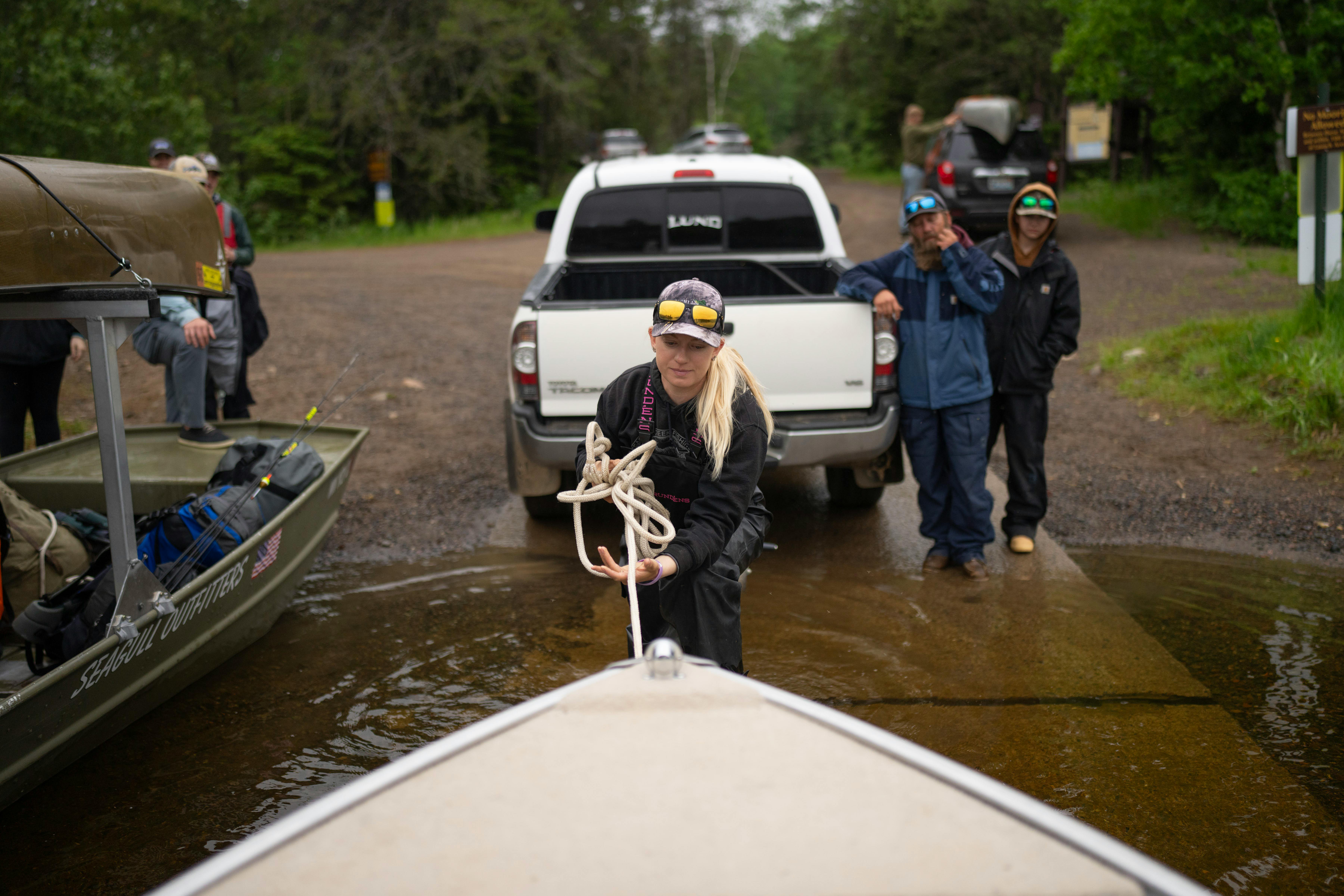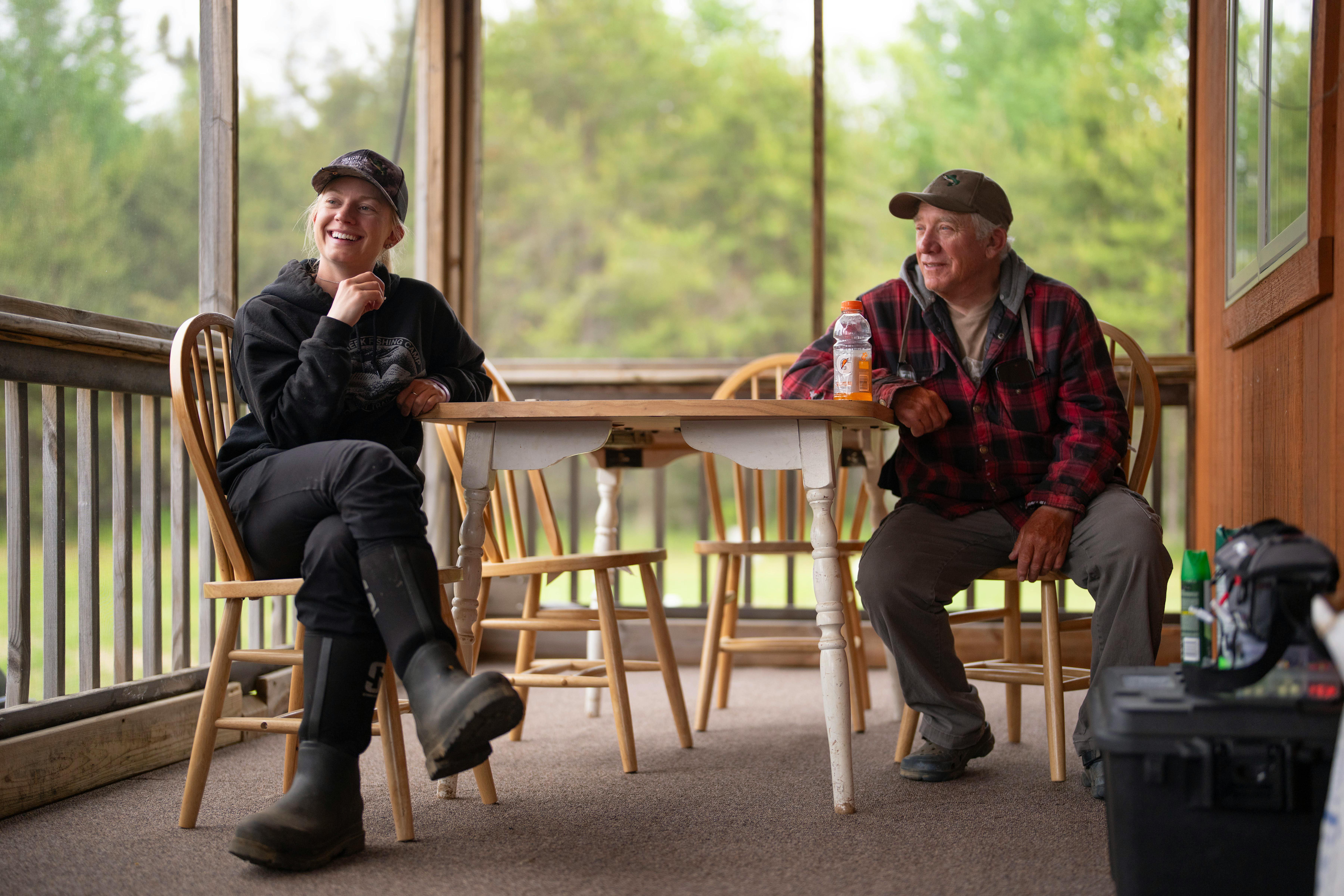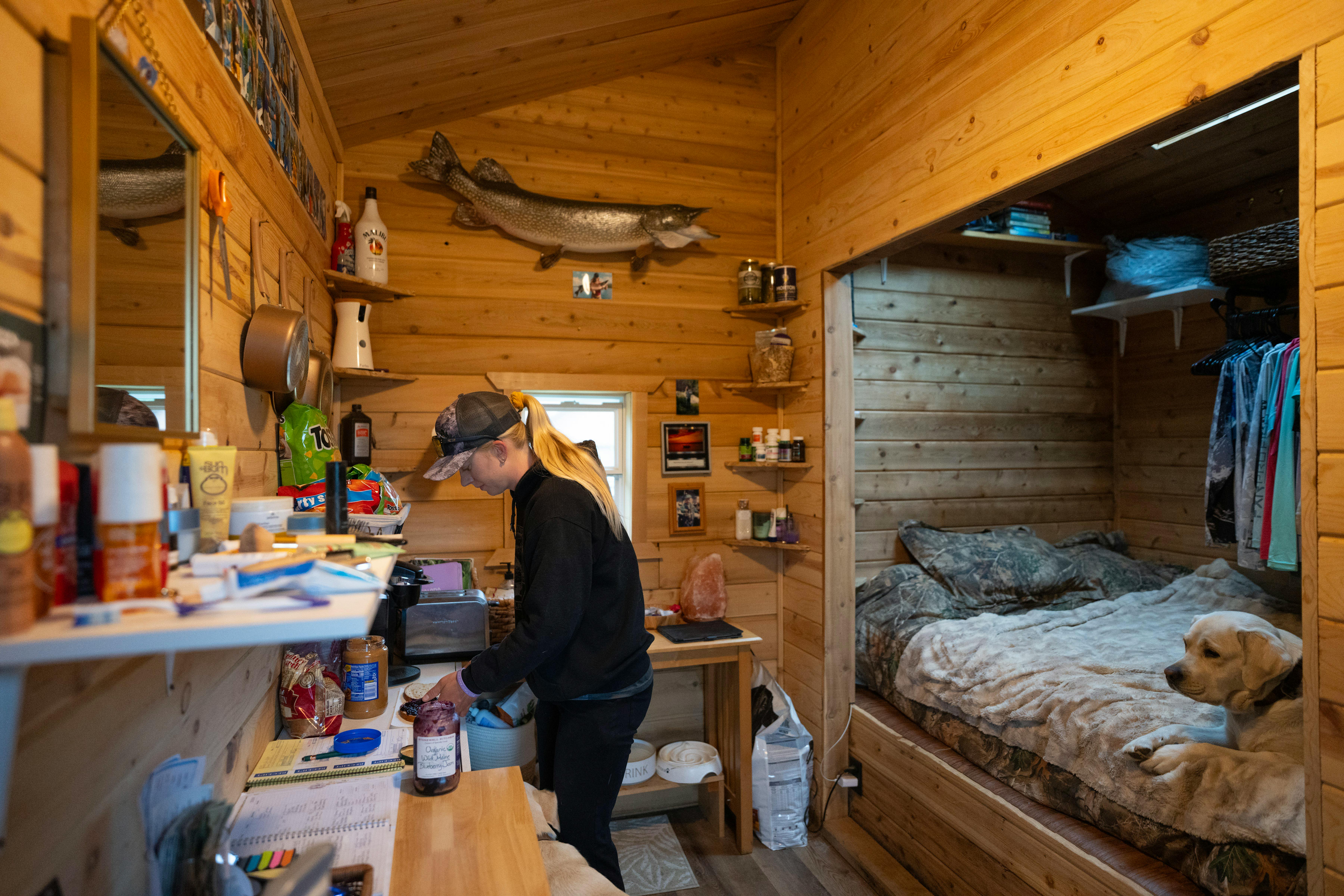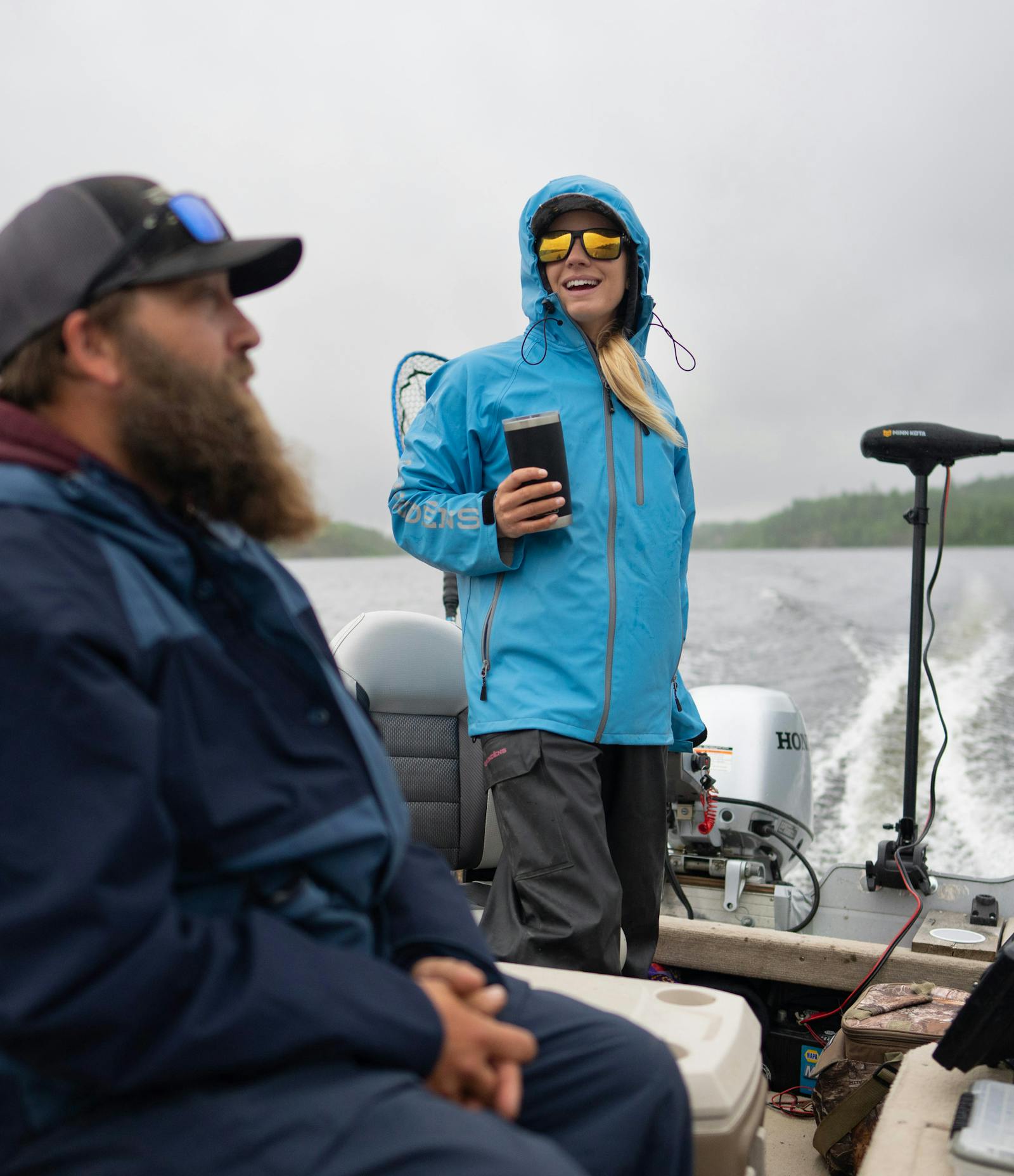There were days while sunning on Waikiki Beach when Jessica Berg-Collman convinced herself that Hawaii could be her forever home.
Transplanted there from Minnesota's forested Gunflint Trail, she fell for Honolulu's tropical charm. When she dropped out of school at Hawaii's flagship university, she stayed to soak up daily life. She learned to surf, worked as a nanny, sold tacos from a food truck and was cast as an extra for two episodes of Hawaii Five-0. Best of all, she was hired as first mate on the Mana Kai catamaran.
"We'd throw out some fishing lines and catch a wahoo or a mahi-mahi," she recalled. "Then we'd filet it and we'd eat it raw. That was just right up my alley."
Six years removed from the Honolulu and still only 27 years old, Berg-Collman's new happy place is her old one. She's back on the Gunflint with plans to take over and sustain a rustic fishing camp founded in 1979 by her locally famous father, Mike Berg.

"She can do it," said her mother, Julie Collman, a former Cook County deputy sheriff. "She's a firecracker. She'll kick anyone's butt."
Raised with the help of friends and family along the Gunflint and in her mother's hometown of Cromwell, Minn., Jessica raced sled dogs for six years starting at 11. In the same time period, she trained heavily for international competitions in log rolling and boom running, winning the semi-pro world championships at age 16 and later, as a pro, finishing fourth in the world in boom running. She's a bow hunter, snowmobiler, horse rider, steelheader, snowboarder, newly trained carpenter, youth basketball coach, and a Lake Superior surfer. Though standing only 5-foot-5, she's strong enough to work all day with a chainsaw and she threw the shot put for her high school track team.
Reflecting on why she left Hawaii, she said the thrills wore off. She couldn't live without the north country's lakes, loons, pines and four seasons.
"I like having the wilderness at my fingertips. There's so much to do," Jessica said. "I started to get bored in Hawaii."



"Hawg" heaven
In his understated way, Mike Berg can visualize Jessica and one of her brothers keeping Seagull Creek Fishing Camp alive for another generation. Years from now, it's possible that her sibling, Curtis Blake, could move home from Devil's Lake, N.D., where he has worked as a fishing guide. The two of them would step up and their dad would step back. Jessica said their camp is the oldest resort on the Gunflint primarily dedicated to fishing.
"I'm in the fourth quarter," Berg said. "They're crazy but, yeah, they can make a go of it if they're willing."
His biggest concern is the constant threat of regulatory changes. To operate as guides on the Ontario portion of Saganaga Lake and on Northern Light Lake, Canada must issue work permits. The camp also relies on Canada for the licensing to trap leeches and minnows. Meanwhile, if the U.S. Forest Service ever kills all remaining motorized travel in the Boundary Waters Canoe Area Wilderness, it would eliminate the camp's traditional access to "Sag."
"I worry about the politics," Berg said. "You just never know."
Jessica calls her father "the quiet legend." He's not the type to crow about his daughter's success on the water. On the other hand, he asks, what's not to like?
The camp operates with three full-time guides, including Stephen Foster in his 34th season. Their signature specialty is giving customers a chance to catch and release a once-in-lifetime trophy walleye. The guides track those catches — including their own — on a giant "Hawg Board" back at camp. (An electronic version tracks every Hawg caught since 2001.) To qualify, a walleye must measure at least 28 inches. The listings record who caught the fish, what tackle it was caught on, how many inches it measured and the lake. On the hush-hush, the guides keep their own leaderboard to see whose boat is catching the most.
Last year, by season's end, Jessica caught 14 Hawgs and her customers caught 28. This year, in the first four weeks alone, she caught 11 Hawgs during a hot streak that included numerous "slam sessions" where customers pounded the walleyes.
"She's easy to work with on the water, and what more can she do?" her father said when asked how she's working out. "She treats the lake like it's her own. … I'm very happy."

Gonzo genes
If there's such a thing as a gonzo gene, it's quite possible that Jessica inherited a pair of them: one from each parent. Mike and Julie never married, but they lived together at the fishing camp for the first four years of Jessica's life. About 36 hours after Jessica was born, Julie and Mike took her fishing with them on Sag, the deepest and largest lake in the BWCAW.
Julie smiled broadly at the memory, then deadpanned: "She was fine. … We had her in a car seat."
Jack Stone owns a premier outdoors gear store in Grand Marais. He knows the family and wishes Jessica still worked for him as a sales clerk.
"I wanted her to take people out fishing this winter as a guide, but she was working construction," he said. "Everyone who has ever fished with her says she's just phenomenal.' "
Besides the mentoring Jessica gets from her father, her mother is "an absolute fishing machine," Stone said.
He remembers a day when Julie came flying into his store on First Street to rip him a new one. "She said, 'One of your guides is taking people to my spot on Kimball [Lake]!' "
It's a story he tells to describe the family's intensity about the outdoors. Before joining the Cook County Sheriff's Department, Julie spent six years as a wilderness guide for the Forest Service. She has been involved in dog sledding, has worked in town at a veterinary clinic, builds log homes during the winter, works summers at a Gunflint Trail resort, hunts deer, camps and is highly secretive about where she picks wild blueberries.
Julie and Jessica made headlines on the North Shore in 2018 when they caught back-to-back northern pike on Sag. Each fish measured about 45 inches long, an inch and a quarter shy of the state record.
"The competition between them is unbelievable when it comes to fishing," Stone said.
As for Mike, he had the gumption as a teenager in the late 1970s to leave his boyhood home in Burnsville to pursue fishing for a living in the northwoods. When he showed up at a big resort at the end of the Gunflint, the owners offered him a job in the kitchen. "I didn't come up here to wash pots and pans," he told them.
By chance, the late Gordy Poehls took Berg under his wing, teaching him how to find and catch walleyes and lake trout. At the time, Poehls was Saganaga's alpha guide. Mike followed in his footsteps and by now could draw his own map of the lake's underwater contours — all 22 square miles.
His self-made fishing camp includes his year-round house, a converted sauna where Jessica lives, three guest cabins, a fish-cleaning hut, ample parking space for boat trailers and an indoor-outdoor kennel for Jessica's beloved white Labrador retrievers, Winter and Stormi. There's also an outbuilding decorated on its interior with decades of newspaper clippings and photos. They honor Poehls, other Gunflint characters, Berg's own celebrity and tales related to the 1979 catch on Seagull River of the Minnesota state record walleye: 35¾ inches long, weighing 17 pounds, 8 ounces.

Ready to pounce
Jessica cuts the motor on her 16-foot Lund Explorer, a treasured vessel she had customized last winter with pearl-white paint and silver glitter. The boat glides into a pocket of shoreline near a 4-foot-high water tank hidden in the bush. It's a bit after 8 a.m. in late May. Each day of fishing on the Canadian side of Saganaga requires a pit stop here to fetch minnows and/or leeches from a private stash.
Stocked for the day, she pushes off and hops back in with lightness of foot. "Should we try for a few lake trout?" she asks. With a steady hand on the tiller, Jessica angles the boat over a reef and watches the boat's fish finder until she sees a trout. When she gives the order to fish, the three of us, including Grand Marais resident Joe Friedrichs, drop our jigs and minnows overboard.
The lines are precisely vertical to the bottom and Joe reels in a keeper within 10 minutes. Jessica eyes the spot and immediately flips an inexpensive buoy marker into the water. In no time, she hooks an even larger laker with orange-hued fins that she explains will give us salmon-colored filets. She flips the trout into a Coleman cooler and off we go.
For eight straight hours, Jessica keeps us on fish and entertains us with her knowledge of walleye movements and with her own homespun theories about the natural world.
Using a walkie-talkie, she occasionally peppers her dad with questions about the bite and what colors are attracting the big ones. He is fishing nearby, and the two of them are attuned to variables that might be affecting the catch rate: drift speed, direction of travel, water depth, wind, water temps, substrates and other factors.,
Jessica's boat is full of conversation, but inwardly she's ready to pounce on the next fish. While dangling jumbo leeches on our sliding sinker rigs, the three of us combine to reel in 10 or more walleyes longer than 21 inches. The 29½-incher I caught was a certified Hawg and a personal best.



Sweet home
Dianne Wimmer ran Loon Lake Daycare for 38 years on the Gunflint Trail. None of the kids she helped raise was more memorable than Jessica. She kept loose reins on the fearless, happy, "super-adventurous" kid who thrived outdoors, climbing trees, building forts, canoeing and riding bikes in the snow. "She would want to be on the roof of our house … so we did all that," Wimmer said.
The two of them have stayed close, but even Wimmer was surprised when Jessica asked her to go horseback riding and canoeing on her 21st birthday. "I thought she was joking," Wimmer recalled. "She said, 'No joke. I'm going to hang out with my mom and you.' "
As much as fishing, hunting and the outdoors summoned Jessica to return from Hawaii, she was also drawn back by her experiences and her connections to people.
She learned to drive in a single-cab Ford F-150 pickup truck that her mom won in a fishing contest. She mastered the game of liar's dice after being taught how to play it by her dad and other fishing guides. In her childhood, "story time" meant taking a break from fishing to stop at Dickie Powell's cabin on Saganaga to eat candy bars and listen to him talk about the old days.
Decades from now, she might spin similar tales about trapping minnows and leeches in the backcountry. To get there, she and her dad travel 11 miles by boat and another three miles by ATV in all kinds of nasty weather.
"That's a big part of living up here is the suffering," said Jessica, who typically guides 14 to 17 days in a row before giving herself a break. "I was taught at an early age that you have to suffer."
Jessica doesn't second-guess leaving Honolulu, but she muses about not finishing college. She took classes in psychology, business, athletic training and world religion, but nothing clicked for a career. Back home at her father's no-frills fishing camp, she has found what she was looking for and it's not wholly about monster walleyes.
Cruising past islands en route to a favorite fishing hole, she conjured up what the lake has offered not only to her but to its Native inhabitants, fur traders and white settlers.
"Sag just has everything you want and need," she said. "It's my family and all those people and the history that make this Lake Sag."
